What is a Quadrilateral?
A quadrilateral is a polygon having four sides, four angles, and four vertices. The word ‘quadrilateral’ is derived from the Latin words ‘quadri,’ which means four, and ‘latus’, which means side.
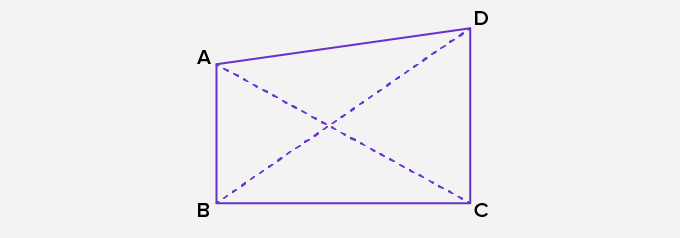
The above image is an example of a quadrilateral.
 Begin here
Begin here
Parts of a quadrilateral
- ∠A, ∠B, ∠C, and ∠D are the four angles of the quadrilateral ABCD
- AB, BC, CD, and DA are the four sides of the quadrilateral ABCD.
- A, B, C, and D are the four vertices of the quadrilateral ABCD.
- AC and BD are the two diagonals of the quadrilateral ABCD.
Non-examples of Quadrilaterals
Shapes that do not have four sides or four angles or have curved sides or are open shapes are non-examples of quadrilaterals.

The above images are some non-examples of quadrilaterals.
Real-life examples of Quadrilaterals
There are many real-life quadrilateral examples: cards, chess boards, traffic signs, etc.
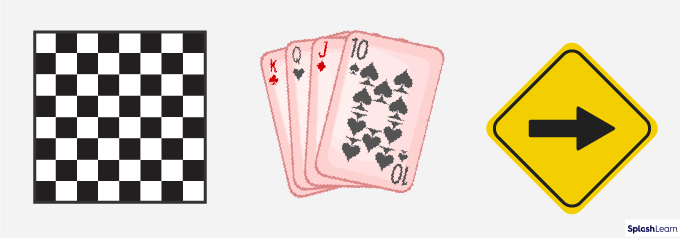
Properties of Quadrilaterals
Some properties are common to all quadrilaterals. These properties are:
- They have four vertices.
- They have four sides.
- The sum of all interior angles is 360°.
- They have two diagonals.
- A quadrilateral can be regular or irregular. A regular quadrilateral must have 4 equal sides, and 4 equal angles, and its diagonals must bisect each other. Square is the only quadrilateral that satisfies all these conditions.
Types of Quadrilaterals
Quadrilaterals can be classified into Parallelograms, Squares, Rectangles, and Rhombuses. Square, Rectangle, and Rhombus are also Parallelograms.
Here’s a list of the types of quadrilaterals with their name, pictures, and properties:
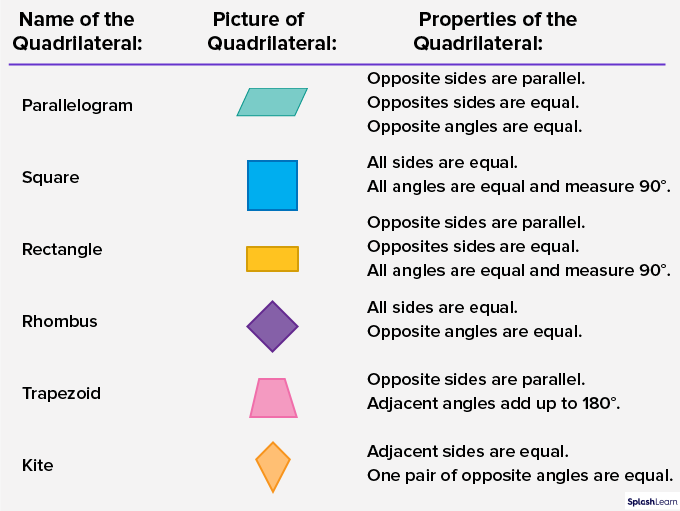
Concave and Convex Quadrilaterals
Concave quadrilaterals: In concave quadrilaterals, one interior angle is greater than 180°.
A quadrilateral is called a concave quadrilateral if at least one diagonal, i.e. the line segment joining the vertices is not a part of the same region of the quadrilateral.
Convex quadrilaterals: In convex quadrilaterals, each interior angle is less than 180°. A quadrilateral is convex if the line segment joining any of its two vertices is in the same region.
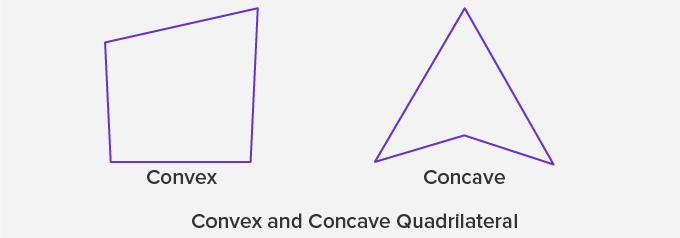
Perimeter of Quadrilateral
The perimeter of a quadrilateral is the length of its boundary. This means the perimeter of a quadrilateral equals the sum of all the sides. If ABCD is a quadrilateral then its perimeter will be: AB + BC + CD + DA
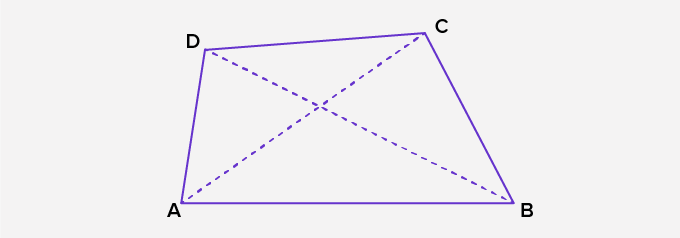
Perimeter of quadrilateral ABCD = AB + BC + CD + DA
The formula for the perimeter of some of the common quadrilaterals is given below:
| Quadrilateral Name | Perimeter |
| Rectangle | 2 (length + width) |
| Square | 4 x Side |
| Rhombus | 4 x Side |
| Parallelogram | 2 x sum of adjacent sides |
| Kite | 2 x sum of adjacent sides |
Area of Quadrilateral
The area of the quadrilateral is the region enclosed by all its sides. The formulas to find out the area of different types of quadrilaterals are shown below:
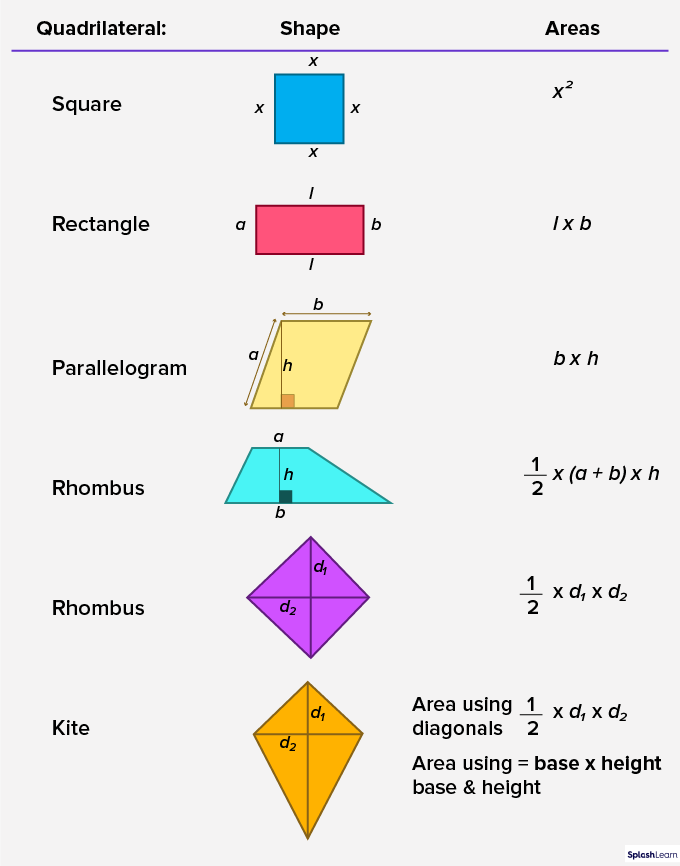
Solved Examples on Quadrilateral
Example 1. Find the missing angle in the given quadrilateral.
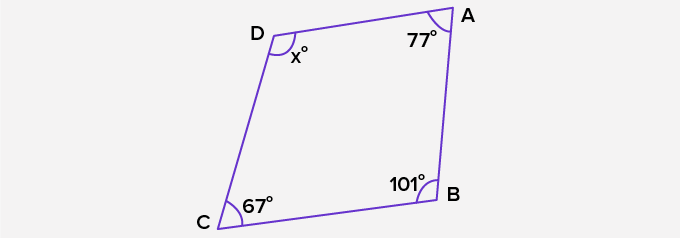
Solution:
We know that the sum of all the angles of a quadrilateral is 360°.
Hence, we can write it as follows:
x + 77° + 101° + 67 = 360°
x + 245° = 360°
x = 360° – 245°
Therefore, x = 115°
Example 2: What will be the perimeter of a quadrilateral with sides 6 cm, 8 cm, 10 cm, and 12 cm?
Solution:
Given, the sides of a quadrilateral are 6 cm, 8 cm, 10 cm, and 12 cm.
Therefore, perimeter of quadrilateral is:
P = 6 cm + 8 cm + 10 cm + 12 cm = 36 cm
Example 3: If the area of a rhombus is 60 square units and its height is 6 units, what will be the value of its base?
Solution:
In the above example, it is given that –
Area of the Rhombus = 60 square units
Height of the Rhombus = 6 units
Area of rhombus = Base x Height
60 = Base x 6
Base = 60/6 = 10 units
Conclusion
This article has taught us that a quadrilateral is a closed-shape polygon with four sides, four angles, and four verticals. In SplashLearn, your child can learn about quadrilaterals in a fun and gaming way. This easy and unique method of learning quickly grabs the attention of young learners. Therefore, parents and teachers can teach quadrilaterals to their children without much effort.
If you are also a parent of a kid studying in a lower grade and looking for trustable online educational platforms, you can enroll them in SplashLearn. Let your child enjoy practicing mathematics fearlessly and sign up for SplashLearn for free.
Practice Problems on Quadrilateral
Quadrilaterals
What type of quadrilateral has all angles measuring 90°, and opposite sides measuring equal?
A rectangle is a four-sided polygon with all angles measuring 90° each and both the pair of opposite sides equal.
How many sides are there in a quadrilateral?
A quadrilateral is a 4-sided polygon.
What is the sum of all the interior angles of a quadrilateral?
This article has taught us that a quadrilateral is a closed-shape polygon with four sides, four angles, and four verticals. In SplashLearn, your child can learn about quadrilaterals in a fun and gaming way. This easy and unique method of learning quickly grabs the attention of young learners. Therefore, parents and teachers can teach quadrilaterals to their children without much effort.
Frequently Asked Questions on Quadrilateral
How many vertices does a quadrilateral have?
A quadrilateral has four vertices.
Can we say a parallelogram is a quadrilateral?
Yes, a parallelogram is a closed figure with four angles. Hence it can be called a quadrilateral.
What is the name of that quadrilateral whose all angles measure 90°, and the opposite sides are equal?
Rectangle
Can all the angles of a quadrilateral be acute?
No, all the angles of a quadrilateral cannot be acute because then the sum of angles of the quadrilateral will be less than 360°.








